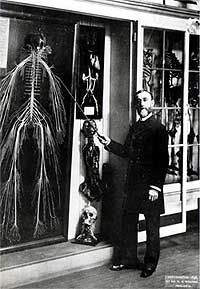Harriet

Dr. Rufus B. Weaver with Harriet
Reproduced courtesy of the Archives and Special Collections, Hahnemann Collection, MCP Hahnemann University
Once Hahnemann Medical College had an extensive museum, now reduced to a few interesting showcases. The centerpiece of the modest display at the entrance to the school's library is one of the world's most fascinating and unusual medical specimens.
What seems like a weird example of string art in human form is all that is left of Harriet Cole, an African-American scrubwoman at the medical school who died in 1888. Apparently, the cleaning lady was interested in anatomy and willed her body to the school. Dr. Rufus B. Weaver, the school's foremost anatomy professor had a special project in mind for Harriet — a project many colleagues thought impossible.
Weaver spent five exhausting months — working eight to 10 hours a day — painstakingly removing every bit of bone and flesh from the cadaver leaving only the nervous system and eyes. During the dissection each strand was wrapped in gauze and kept moist with alcohol and finally preserved with white lead-based paint and shellac. The exposed nervous system was then mounted on a board with hundreds of tiny pins.
Harriet was displayed at the 1893 Colombian Exposition in Chicago where it was awarded a gold medal and blue ribbon. Life Magazine published a nice photo essay on Harriet in 1960. She was also featured in Time Magazine and a number of medical books. You can see Philadelphia's most famous bundle of nerves near the 15th and Vine streets school entrance.



